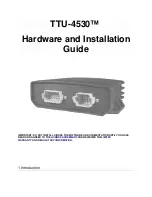
Copyright
©2010 EU3C Company Limited Reserved® All rights reserved.
This publication is protected by federal copyright law. No part of this publication may be copied or distributed, transmitted, transcribed, stored in a
retrieval system, or translated into any human or computer language in any form or by any means, electronic, mechanical, magnetic, manual or
otherwise, or disclosed to third parties without the express written permission from EU3C.
EU3C makes no representation or warranties with respect to the contents hereof and specifically disclaims any implied warranties of merchantability or
fitness for a particular purpose.
Trademarks
EU3C is a registered trademark of EU3C Company Limited Reserved. The EU3C logo is a trademark of EU3C Company Limited Reserved. All other
registered and unregistered trademarks are the properties of their respective holders.
FCC Regulations
This GPS tracker complies with part 15 of the FCC Rules. Operation is subject to the following two conditions: (1) This device may not cause harmful
interference, and (2) this device must accept any interference received, including interference that may cause undesired operation.
This GPS tracker has been tested and found to comply with the limits for a Class B digital device, pursuant to Part 15 of the
FCC Rules. These limits are
designed to provide reasonable protection against harmful interference in a residential installation. This equipment generates, uses and can radiated
radio frequency energy and, if not installed and used in accordance with the instructions, may cause harmful interference to radio communications.
However, there is no guarantee that interference will not occur in a particular installation If this equipment does cause harmful interference to radio or
television reception, which can be determined by turning the equipment off and on, the user is encouraged to try to correct the interference by one or
more of the following measures:
•
-Reorient or relocate the receiving antenna.
•
-Increase the separation between the equipment and receiver.
•
-Connect the equipment into an outlet on a circuit different from that to which the receiver is connected.
•
-Consult the dealer or an experienced radio/TV technician for help.
Changes or modifications not expressly approved by the party responsible for compliance could void the user's authority to operate the equipment.
The antenna(s) used for this transmitter must not be co-located or operating in conjunction with any other antenna or transmitter.
RF Exposure Information (SAR)
This GPS tracker meets the government's requirements for exposure to radio waves.
This tracker is designed and manufactured not to exceed the emission limits for exposure to radio frequency (RF) energy set by the Federal
Communications Commission of the U.S. Government.
The exposure standard for wireless mobile phones employs a unit of measurement known as the Specific Absorption Rate, or SAR. The SAR limit set by
the FCC is 1.6W/kg. *Tests for SAR are conducted using standard operating positions accepted by the FCC with the phone transmitting at its highest
certified power level in all tested frequency bands. Although the SAR is determined at the highest certified power level, the actual SAR level of the
tracker while operating can be well below the maximum value. This is because the tracker is designed to operate at multiple power levels so as to use
only the poser required to reach the network. In general, the closer you are to a wireless base station antenna, the lower the power output.
The highest SAR value for the model tracker as reported to the FCC when tested for use at the ear is 1.31 W/kg and when worn on the body, as
described in this user guide, is 0.323 W/kg (Body-worn measurements differ among tracker models, depending upon available accessories and FCC
requirements.)
While there may be differences between the SAR levels of various phones and at various positions, they all meet the government requirement.
The FCC has granted an Equipment Authorization for this model tracker with all reported SAR levels evaluated as in compliance with the FCC RF
exposure guidelines. SAR information on this model tracker is on file with the FCC and can be found under the Display Grant section of
www.fcc.gov/oet/ea/fccid after searching on FCC ID: WFZGT100A.
For body worn operation, this tracker has been tested and meets the FCC RF exposure guidelines for use with an accessory that contains no metal and
the positions the handset a minimum of 1.5 cm from the body. Use of other accessories may not ensure compliance with FCC RF exposure guidelines.
If you do no t use a body-worn accessory and are not holding the phone at the ear, position the handset a minimum of 1.5 cm from your body when the
tracker is switched on.
Revisions
Product features and specifications described in this manual are subject to change without notice. EU3C reserves the right to periodically revise this
manual without notice. Revisions will be incorporated into new editions. EU3C shall not be liable for any damages, or for the loss of information resulting
from the performance or use of the information contained herein.
EU3C Communications
Unit 7, 8/F., Austin Tower, 22-26 Austin Avenue,
Tsim Sha Tsui, Kowloon, Hong Kong
Содержание GT100A
Страница 16: ...3 4 Proprietary to EU3C Company Limited Reserved Tracker GT100 User Guide Powering Up the Tracker GT100 ...
Страница 28: ...4 12 Proprietary to EU3C Company Limited Reserved Tracker GT100 User Guide Changing the Password ...
Страница 32: ...A 2 Proprietary to EU3C Company Limited Reserved Tracker GT100 User Guide Technical Specifications ...



































